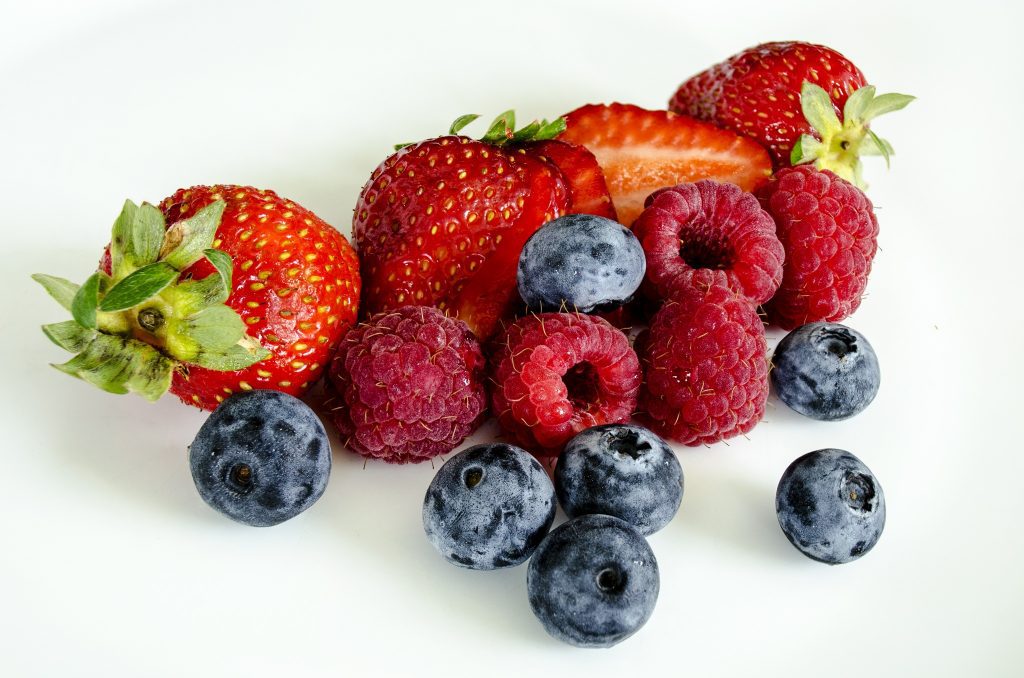
Here you’ll discover what makes berries such an effective natural gout remedy, including my top 7 berries for relieving the painful symptoms of gout.
Berries and Gout
Berries are highly beneficial for overall health due to their being extremely rich in antioxidants, fiber, vitamins and minerals. They are also some of the lowest calorie fruits around.
But, apart from being excellent for your health, they’re also very effective as a natural gout remedy and well worth adding to a well-balanced gout diet.
Here you’ll discover why berries are such an awesome home remedy for gout. You’ll also discover the top 7 most effective berries for relieving the painful symptoms of gout attacks (a.k.a. gout flares).
Gout
Gout is a very painful form of arthritis — hence sometimes called ‘gouty arthritis’ — whose root cause is abnormally high uric acid levels in the body, a condition called ‘hyperuricemia’.
Such high levels of uric acid can trigger the formation of tiny uric acid crystals in the joints and surrounding soft tissue. Your body’s natural inflammatory response to these crystals causes the typical gout symptoms of inflammation, swelling, shiny taught red skin, hot/warm to the touch, stiffness, and excruciating joint pain. The big toe is the most common location (around 70% of instances) although any joint can be affected.
Uric acid is a byproduct of purine metabolism. Purines are natural organic compounds found in the cells of all living things, including we humans, animals and plants. As cells die their purines break down forming uric acid in the process.
Your kidneys normally excrete excess uric acid via urine. But sometimes the body produces too much uric acid for the kidneys to handle. This results in a build-up of uric acid in the blood and an increased risk of gout attacks. This can also happen if the kidneys aren’t working to their full potential.
A doctor will normally prescribe anti-inflammatories, such as ibuprofen and indomethacin, to help relieve the painful symptoms of a gout attack and uric acid-lowering medication, such as allopurinol and febuxostat, to help manage uric acid levels.
And, since more purines means more uric acid, they’ll likely advise you to make some dietary changes.
This usually entails changing to a low-purine diet that completely avoids foods high in purines (such as organ meats, wild game and certain seafood) but allows limited amounts of foods with moderate purine concentrations (such as red meat, poultry and some seafood).
Low-purine foods are things like fruit, berries, nuts, most vegetables, low-fat dairy products, whole grains and, surprisingly, a small selection of seafood like crayfish.
But there are also many natural remedies for gout out there, one of the most popular being berries…
Berries
According to Wikipedia…
“Berries have been valuable as a food source for humans since before the start of agriculture and remain among the primary food sources of other primates. They were a seasonal staple for early hunter-gatherers for thousands of years, and wild berry gathering remains a popular activity in Europe and North America today. In time, humans learned to store berries so that they could be used in the winter, and they may be made into fruit preserves, and among Native Americans, mixed with meat and fats as pemmican.
Berries also began to be cultivated in Europe and other countries. Some species of blackberries and raspberries of the genus Rubus have been cultivated since the 17th century, while smooth-skinned blueberries and cranberries of the genus Vaccinium have been cultivated in the United States for over a century. In Japan, between the 10th and 18th centuries, the term “ichibigo” (which later became “ichigo“) referred to many berry crops. The most widely cultivated berry of modern times, however, is the strawberry, which is produced globally at twice the amount of all other berry crops combined.”
Benefits of Berries for Gout
So what is it about berries that makes them such an effective natural gout remedy? Three things in particular stand out: anthocyanins, quercetin and vitamin c…
Anthocyanins
Anthocyanins are plant pigments that help give fruit and vegetables their red, purple and blue colors; the darker the hue the higher the concentration of anthocyanins.
They also have powerful antioxidant properties that can scavenge and neutralize cell-damaging molecules called ‘free radicals’. Experts believe that free radical damage is the basis of many chronic diseases, such as heart disease, diabetes, and cancer.
And they have powerful anti-inflammatory properties due to their ability to inhibit inflammatory mediators. This is important for gout where a flare-up is caused by the body’s inflammatory response to the presence of monosodium urate crystals in the joints and surrounding tissue.
Chokeberries are particularly rich in anthocyanins, along with black raspberries and blueberries. Red raspberries, acai berries, and dark cherries are also very good sources.
Other good sources are mulberries, elderberries, bilberries, blackberries, black and red currants.
Quercetin
Quercetin is another powerful antioxidant with anti-inflammatory properties found in plant-based foods. Studies have shown that quercetin can also inhibit the production of uric acid.
Elderberries, cranberries, chokeberries, blueberries, bilberries, blackberries, and dark cherries contain substantial concentrations of quercetin.
Vitamin C
Vitamin C (ascorbic acid) has been shown in studies to increase uric acid excretion and reduce uric acid levels in the blood.
In addition, it’s an important element in the healing process for tissue damaged by crystals during a gout flare. In fact, vitamin C is a powerful antioxidant in its own right.
Strawberries, raspberries, acerola cherries, black currants, and blackberries, are packed with vitamin C. Blueberries, cranberries, and sweet cherries are also very good sources of vitamin C.
How to Take Berries
At least one cup of fresh, ripe, organic berries should be consumed daily. As berries are seasonal you can also freeze them, ready to be consumed out of season. You can add them to smoothies, yogurt, and cereal. Natural berry juice without any additives is okay too.
The ripest berries with the richest, darkest colors have the highest concentrations of antioxidants. So try to stick to them.
And of course those berries, like chokeberries, that are hard to eat raw because of their bitterness can be drunk as a natural juice, but without added sugar.
Note: Be very careful with elderberries though: these shout NOT be eaten raw since their seeds contain cyanide. Drink elder berry juice instead.
My Top 7 Berries for Natural Gout Relief
My top 7 berries for gout in terms of their anthocyanins, quercetin and vitamin C content, along with their ease of availability are:
- cherries
- blueberries
- bilberries
- blackberries
- strawberries
- raspberries
- black / red currants
Stick to these and you can’t go wrong.
Of these, cherries are probably the most studied in terms of their effectiveness as a gout home remedy. Several studies have shown that they can both relieve inflammation and reduce blood uric acid levels. So, not only are they great during a gout flare-up, they are also effective in helping to prevent future attacks by first lowering, then maintaining, healthy uric acid levels.
Note: Although cranberries are high in quercetin and vitamin C, on balance, it’s probably safer for gout sufferers to avoid these. Cranberries appear, in studies, to lower urine pH (making it more acidic) which is bad for gout since it can result in less uric acid being excreted, resulting in higher uric acid levels in the blood. They’re also high in oxalate (oxalic acid) which can put you at a higher risk of kidney stones.
So there you have it; a daily serving of fresh berries isn’t only very beneficial for your overall health, they also make for a very effective natural remedy for gout.



